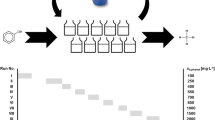Abstract
The combined influence of high phenol concentrations and low temperatures on aerobic and anaerobic phenol degradation kinetics was investigated in microbial enrichment cultures to evaluate temperature-inhibition relationships with respect to the ambient conditions in polluted habitats. The inhibition of microbial phenol degradation by excess substrate was found to be temperature-dependent. Substrate inhibition was intensified when temperatures were lower. This results in an elevated temperature sensitivity of phenol degradation at inhibitory substrate concentrations.
The synergistic amplification of substrate inhibition at low temperatures may help to explain the limited self-purification potential of contaminated habitats such as soils, sediments and groundwater aquifers where high pollutant concentrations and low temperatures prevail.
Similar content being viewed by others
References
Abel, P.D.: Water pollution biology. Ellis Horwood Ltd., Chichester (1989)
Cairns, J. Jr.;A.G. Heath;B.C. Parker: The effects of temperature upon the toxicity of chemicals to aquatic organisms. Hydrobiol.47, 135–171 (1975)
Duangsawadsi, M.; J.F. Klaverkamp: Acephate and fenitrothion toxicity in rainbow trout: Effects of temperature stress and investigations on the site of action. In Aquatic Toxicology. Proceedings of the Second Annual Symposium on Aquatic Toxicology. Marking, L.L., Kimerle, R.A. (eds.) (1979)
Smith, M.G.;A.G. Heath: Acute toxicity of copper, chromate, zinc and cyanide to freshwater fish: effect of different temperatures. Bull. Environ. Contam. Toxicol.22, 113–119 (1979)
Felts, P.A.;A.G. Heath: Interactions of temperature and sublethal environmental copper exposure on the energy metabolism of the bluegill,Lepomis macrochirus Rafinesque. J. Fish Biol.25, 445–453 (1984)
Khangarot, B.S.;P.K. Ray: Studies on the acute toxicity of copper and mercury alone and in combination to the common guppyPoecilia reticulata (Peters). Arch. Hydrobiol.110, 303–314 (1987)
Pfeiffer, S.;O. Manns: Photometrische Bestimmung einiger Arzneimittel mit 4-Aminoantipyrin. Pharmazie12, 401–408 (1957)
Edwards, V.H.: The influence of high substrate concentrations on microbial kinetics. Biotechnol. Bioeng.12, 679–712 (1970)
Westermann, P.;B.K. Ahring;R.A. Mah: Temperature compensation inMethanosarcina barkeri by modulation of hydrogen and acetate affinity. Appl. Environ. Microbiol.55, 1262–1266 (1989)
Magbanua, B.S., Jr.;P.A. Hoover;P.J. Campbell;A.R. Bowers: The effect of cosubstrates on phenol degradation kinetics. Wat. Sci. Tech.30, 67–77 (1994)
Hochachka, P.W.;G.N. Somero: Strategies of biochemical adaptation. W.B. Saunders Company, Philadelphia (1973)
Hazel, J.R.;C.L. Prosser: Molecular mechanisms of temperature compensation in poikilotherms. Physiol. Rev.54, 620–677 (1974)
Prosser, C.L.: Adaptational biology. Molecules to organisms. John Wiley & Sons (1986)
Hugo, W.B.: The action of phenol and 2-phenoxyethanol on the oxidation of various substances byEscherichia coli and by disrupted cell preparation of the organism. J. Gen. Microbiol.15, 315–323 (1956)
Wedding, R.T.;C. Hansch, C.T.R. Fukuto: Inhibition of malate dehydrogenase by phenols and the influence of ring substituents on their inhibitory effectiveness. Arch. Biochem. Biophys.121, 9–21 (1967)
Chang, K.Y.: Interaction of phenol with the polysaccharide of bacterial cell wall. Biochem. Biophys. Res. Comm.51, 900–906 (1973)
Hugo, W.B.: The inactivation of vegetative bacteria by chemicals. In: Inhibition and inactivation of vegetative microbes. The Society of Applied Bacteriology. Symposium series No. 5, 1–11.Skinner, F.A., Hugo, W.B. (eds.), Academic Press, New York (1976)
Keweloh, H.;G. Weyrauch;H.-J. Rehm: Phenol-induced membrane changes in free and immobilizedEscherichia coli. Appl. Microbiol. Biotechnol.33, 66–71 (1990)
Keweloh, H.; H.-J. Heipieper; R. Diefenbach; H.-J. Rehm: Mechanisms of phenol degrading bacteria for the protection from substrate toxicity.
DECHEMA Biotechnology Conference 5, VCH Verlagsgesellschaft (1992)
Author information
Authors and Affiliations
Rights and permissions
About this article
Cite this article
Eismann, F., Kuschek, P. & Stottmeister, U. Microbial phenol degradation of organic compounds in natural systems: Temperature-inhibition relationships. Environ. Sci. & Pollut. Res. 4, 203–207 (1997). https://doi.org/10.1007/BF02986346
Received:
Accepted:
Issue Date:
DOI: https://doi.org/10.1007/BF02986346
Keywords
- Aerobic phenol degradation
- anaerobic phenol degradation
- contaminated habitats
- degradation kinetics
- groundwater aquifers
- kinetics
- organic compounds, microbial phenol degradation
- phenol
- phenol degradation, aerobic
- phenol degradation, anaerobic
- phenol toxicity
- sediments
- self-puri-fication
- soils
- substrate inhibition
- temperature
- temperature compensation
- temperature sensitivity
- toxicity, phenol




